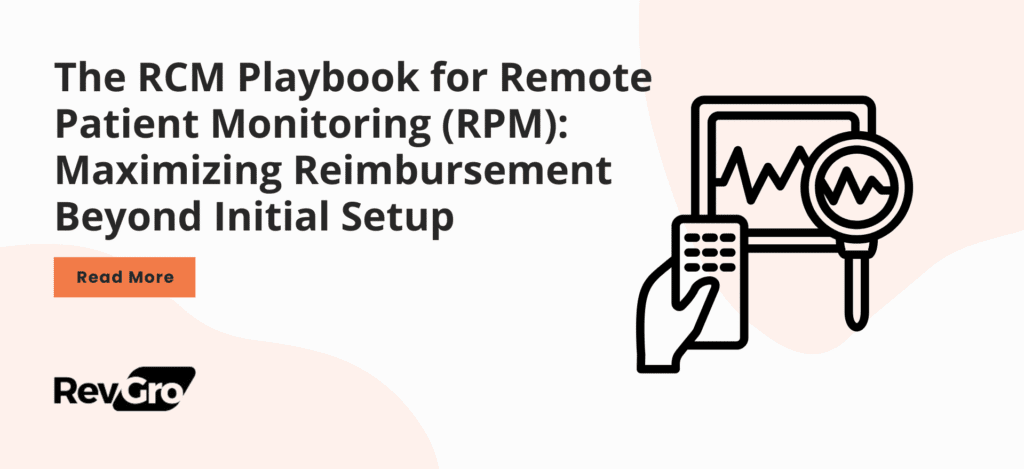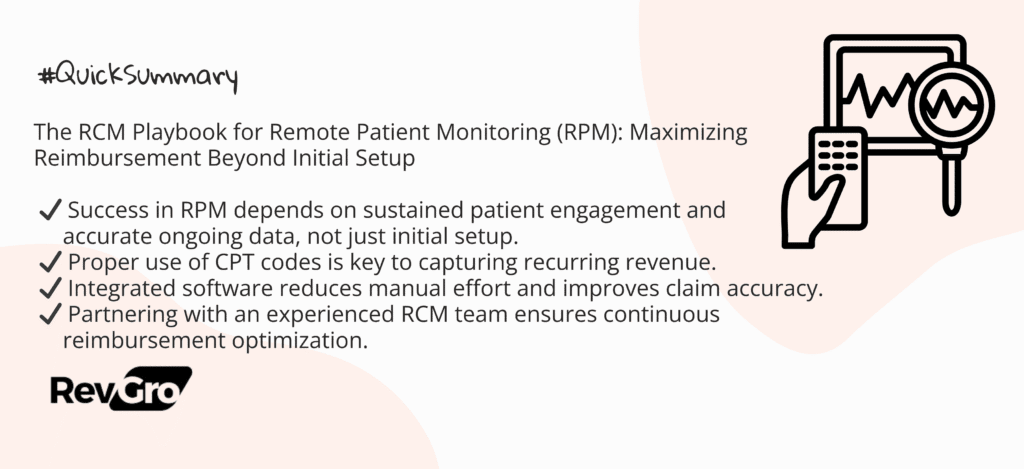
- CPT Codes for Ongoing RPM Billing: Beyond the Basics
- The RCM Playbook: How to Prevent RPM Claim Denials with Proper Documentation
- Master Documentation for Continuous Billing
- Rigorous Patient Consent Management
- Optimizing Telehealth Device Integration for Consistent Reimbursement
- Optimizing Telehealth Device Integration for Consistent Reimbursemente
- Proactive Monitoring and Auditing for RPM RCM
- Staff Training and Workflow Optimization
- Conclusion: Building a Resilient RPM Revenue Streamn

Remote Patient Monitoring (RPM) has revolutionized how healthcare is delivered, allowing providers to extend care beyond clinic walls and proactively manage patient health. From tracking blood pressure in hypertensive patients to monitoring glucose levels for diabetics, RPM offers incredible benefits for patient outcomes and practice efficiency. Yet most practices leave 20–40% of potential RPM revenue on the table. However, for many practices, the journey from merely offering RPM to truly maximizing reimbursement is often fraught with complexity. While understanding the initial setup billing codes (like CPT 99453) is a start, a truly robust RPM RCM strategy delves much deeper.
To build a sustainable RPM program revenue stream, practices must move beyond the basics. It requires an advanced understanding of ongoing documentation, meticulous management of patient consent for data, and optimizing telehealth device billing for consistent reimbursement. Let’s explore the essential components of an RPM RCM playbook that ensures your program’s financial success long after the initial patient onboarding.
CPT Codes for Ongoing RPM Billing: Beyond the Basics
While CPT code 99453 covers the initial setup and patient education for a remote monitoring device, the true revenue potential of RPM lies in the ongoing management and data transmission. This involves a suite of codes, primarily 99454, 99457, and 99458, each with specific requirements that, if not met, can lead to significant RPM reimbursement challenges.
- CPT 99454 (Device Supply & Data Transmission): This code covers the daily supply of the device and the transmission of data. A critical requirement here is that data must be collected for at least 16 days out of a 30-day period. Failing to meet this threshold means this code cannot be billed.
- CPT 99457 (Remote Physiological Monitoring Treatment Management): This covers the first 20 minutes of time spent by a physician or other qualified healthcare professional (QHP) or clinical staff (under general supervision) on monitoring, reviewing, and interpreting RPM data, and engaging in interactive communication with the patient or caregiver during a calendar month.
- CPT 99458 (Additional RPM Treatment Management): This is an add-on code for each additional 20 minutes of clinical staff time per calendar month, beyond the initial 20 minutes covered by 99457.
Understanding these codes is the foundation, but the real challenge lies in consistent execution and meticulous record-keeping to support them. This is where advanced remote patient monitoring billing optimization comes into play.
To ensure your RPM program thrives financially, consider these advanced RCM strategies:
1. Master Documentation for Continuous Billing
Comprehensive and accurate documentation is the bedrock of preventing RPM reimbursement challenges. For every patient on an RPM program, ensure your medical records explicitly capture:
- Medical Necessity: Clearly document the acute or chronic condition being monitored and why RPM is medically reasonable and necessary for that patient’s care plan. This should be re-assessed periodically (e.g., annually).
- 16-Day Data Rule: Maintain clear records demonstrating that at least 16 days of data were collected and transmitted within each 30-day billing cycle for CPT 99454. Your RPM platform should ideally track this automatically.
- Time Logs for Management Codes (99457/99458): Detailed logs are essential, documenting exactly how clinical staff time was spent. This includes reviewing data, analyzing trends, communicating with the patient/caregiver, and adjusting treatment plans. Specify dates, times, activities, and who performed the service.
- Interactive Communication: For 99457/99458, one “interactive communication” (real-time two-way via phone, video, etc., not just text/email) must occur per month. Document the date, time, duration, and content of this interaction.
- Diagnosis and CPT/HCPCS Codes: Ensure correct and up-to-date coding that aligns with the services provided and documented medical necessity.
- Provider and Patient Identification: Each page of documentation should clearly identify the beneficiary, date of service, and provider.
2. Rigorous Patient Consent Management
Patient consent is not a one-time checkbox; it’s an ongoing process, crucial for sustainable RPM program revenue.
- Initial Informed Consent: Obtain explicit patient consent at the time RPM services are furnished. This consent should clearly outline:
- The nature of RPM services.
- The types of data collected (e.g., blood pressure, weight, glucose).
- How the data will be used and shared (e.g., with care team, for billing).
- The patient’s right to withdraw consent at any time without affecting their right to future care.
- Potential risks (e.g., technical failures, privacy breaches).
- Ongoing Acknowledgment: While not always required monthly, consider periodic check-ins to ensure patients remain engaged and understand their participation. This also serves as continued documentation of their agreement.
3. Optimizing Telehealth Device Integration for Consistent Reimbursement
The devices themselves play a critical role in successful telehealth device billing.
- FDA-Cleared Devices: Ensure all RPM devices used meet the FDA’s definition of a medical device. This is a non-negotiable requirement for reimbursement.
- Automatic Data Transmission: For billing CPT 99454, the device must automatically and directly transmit readings to the care team. Manual patient entry of data is generally not reimbursable under these codes.
- Seamless Integration with EHR/RCM: An RPM platform that integrates smoothly with your Electronic Health Record (EHR) and RCM system can dramatically streamline workflows, automate data capture, and reduce manual errors, leading to fewer denied claims.
- User-Friendly for Patients: If patients find the devices difficult to use, adherence will drop, making it challenging to meet the 16-day data requirement for 99454, directly impacting your sustainable RPM program revenue. Prioritize ease of use.
- Technical Support: Ensure there’s a clear process for patients to receive technical support for their devices, minimizing disruptions in data transmission.
4. Proactive Monitoring and Auditing for RPM RCM
Don’t wait for denials. Implement internal processes for:
- Daily Data Monitoring: Ensure that patients are consistently using their devices and transmitting data. Proactive outreach to disengaged patients can prevent lost reimbursement for the 99454 code.
- Claims Scrubber Integration: Use RCM technology with built-in claims scrubbers specifically designed for RPM to catch common billing errors before submission.
- Regular Internal Audits: Periodically audit a sample of your RPM claims and associated documentation to identify any patterns of errors or areas for improvement. This proactive approach significantly strengthens your RPM RCM strategies.
5. Staff Training and Workflow Optimization
Your staff is on the front lines of RPM. Comprehensive training is essential.
- Clinical Staff: Train on proper patient education for device use, understanding data alerts, performing interactive communications, and detailed time documentation.
- Billing Staff: Ensure they are experts in RPM CPT codes, modifiers, payer-specific policies, and common denial reasons.
- Defined Workflows: Establish clear, efficient workflows for patient enrollment, device distribution, data monitoring, clinical intervention, documentation, and billing. This reduces burden and boosts efficiency.
Conclusion: Building a Resilient RPM Revenue Stream
Remote Patient Monitoring is more than just a technological innovation; it’s a profound shift in healthcare delivery with significant financial implications. To truly harness its potential and build a sustainable RPM program revenue stream, practices must adopt a sophisticated RPM RCM strategy. By prioritizing meticulous documentation, securing robust patient consent, optimizing telehealth device billing through seamless integration, and embracing proactive compliance, you can navigate the complexities of RPM reimbursement challenges and ensure your program not only delivers exceptional patient care but also contributes robustly to your practice’s financial health.
Ready to optimize your RPM billing and unlock consistent reimbursement? RevGroMD offers expert Revenue Cycle Management services, specializing in maximizing your telehealth and remote patient monitoring revenue. Contact us today to develop your comprehensive RPM RCM playbook.
